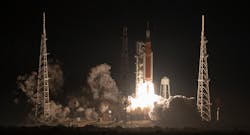NASA’s Artemis I 'mega rocket' launches tech-filled Orion spacecraft to the Moon
KENNEDY SPACE CENTER, Fla., - It was all systems go for the National Aeronautics and Space Administration (NASA) as it announced the successful liftoff of its Space Launch System (SLS). NASA's SLS is the most powerful rocket in the world - it provides 8.8 million pounds of thrust - and launched the agency’s Orion spacecraft at 0147 hours on 16 November 2022. Lockheed Martin Space in Denver is the prime contractor for NASA and built the crew module, crew module adaptor and launch abort system.
The craft is on its way to the Moon as part of the Artemis program. The launch is the first leg of a mission in which Orion is planned to travel approximately 40,000 miles beyond the Moon and return to Earth over the course of 25.5 days. This flight is a significant test prior to flying astronauts on the Artemis II mission.
The launch and following missions were enabled by technology from dozens of industry partners, including Wind River Systems in Alameda, Calif., and Honeywell in Phoenix.
Wind River's VxWorks real-time operating system was selected to aid the SLS's first stage of launch, inside the Orion Crew Vehicle for life support, communications, and Lunar orbit, plus associated science experiments.
In addition, Honeywell provided the full navigation and guidance system for the Artemis I launch vehicle. This allowed the spacecraft to know exactly where it’s going, stay on course and return safely to Earth. Honeywell technology is also helping control the thrust on rockets.
Early in this uncrewed mission, the spacecraft deployed series of 10 small science investigations and technology demonstrations, called CubeSats, from a ring that connected the upper stage to the spacecraft.
Orion’s service module performed the first of a series of burns to keep Orion on course toward the Moon approximately eight hours after launch. Mission controllers at NASA’s Johnson Space Center in Houston will conduct additional checkouts and course corrections as needed. Orion is expected to fly by the Moon on Nov. 21, performing a close approach of the lunar surface on its way to a distant retrograde orbit, a highly stable orbit thousands of miles beyond the Moon.
"The Space Launch System rocket delivered the power and performance to send Orion on its way to the Moon," said Mike Sarafin, Artemis I mission manager. "With the accomplishment of the first major milestone of the mission, Orion will now embark on the next phase to test its systems and prepare for future missions with astronauts."

Jamie Whitney
Jamie Whitney joined the staff of Military & Aerospace Electronics and Intelligent Aerospace. He brings seven years of print newspaper experience to the aerospace and defense electronics industry.
Whitney oversees editorial content for the Intelligent Aerospace Website, as well as produce news and features for Military & Aerospace Electronics, attend industry events, produce Webcasts, oversee print production of Military & Aerospace Electronics, and expand the Intelligent Aerospace and Military & Aerospace Electronics franchises with new and innovative content.

